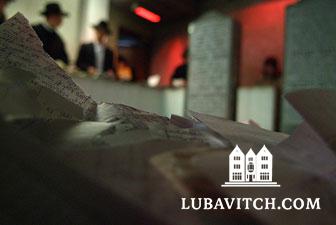Only 57 years ago, a small Jewish group originating in eastern Europe was struggling to reestablish itself in the U.S. Today, Chabad-Lubavitch is arguably the most dynamic factor of Jewish vitality worldwide. On this date in 1951, the Lubavitcher Rebbe, Rabbi Menachem M. Schneerson of blessed memory, assumed leadership of the movement. Today, thousands will visit the Ohel, or the resting place of the Rebbe and his father-in-law, Rabbi Joseph I. Schneersohn.
Today, the 10th of Shevat on the Jewish calendar, is honored by Chabad-Lubavitch chasidim worldwide as a watershed in the movement's history.
In 1950, Rabbi Joseph I. Schneersohn, sixth in the dynasty of Lubavitcher Rebbes, passed away after having relocated the organization's headquarters from Europe to Brooklyn, New York ten years earlier. His leadership spanned thirty years, from 1920-1950–years of severe hardship for Jews, especially in communist Russia where Lubavitch was based. In the 1920s the Rebbe was incarcerated for his activities to strengthen Jewish education and Jewish life.
Once in the U.S., Rabbi Joseph I. Schneersohn laid the groundwork for the Lubavitch movement's activities. He established the offices of the Lubavitch educational and social services divisions, Merkos L'inyonei Chinuch and Machne Israel, respectively, and the Kehot Publication Society–today one of the largest publishers of Jewish books worldwide. He also began to send the first Shluchim–emissaries–to help build Jewish communities in various locations in need of assistance. In the short decade of his leadership in the U.S., Rabbi Joseph I. Schneersohn would establish yeshivas and open many of the first Jewish day schools in the country–an effort that was fraught with resistance–particularly from Jews who, at the time, regarded traditional Jewish life as an unhappy reminder of a life they had hoped to leave behind them.
"World Jewry is deeply indebted to the sixth Rebbe, Rabbi Joseph I. Schneersohn, for transferring Yiddishkeit to the United States, and for laying the groundwork together with his son-in-law, the Rebbe, for the Jewish day school system and Chabad's outreach activities," observed Rabbi Yehuda Krinsky, chairman of the educational and social services divisions of Lubavitch.
Succeeding Rabbi Joseph I. Schneersohn on this day, in 1951, was his son-in-law, Rabbi Menachem M. Schneerson, who enlarged on his predecessor's vision, and directed the movement to a dynamic and highly focused outreach program. At the time, the Jewish community was still shattered, broken in spirit and in body by the Holocaust in which two thirds of Europe's Jewish population were exterminated. The depth and magnitude of Jewish suffering and loss seemed to be the measure for the Rebbe’s vision for Jewish rehabilitation and revival. “The Jewish people has been so heavily decimated,” the Rebbe once said, “that each of us must be made to count, and to count doubly.”
The restoration of Jewish life, Jewish pride, and Jewish identity would be the ever-present theme in the Rebbe’s 44 years of leadership (the Rebbe passed away in 1994). Embracing the freedoms of America, the Rebbe directed his followers to seize the opportunity to live Jewish life fully and boldly, and teach others to do the same. The Rebbe's passion for Jewish life inspired generations of young men and women who would devote their lives to Jewish continuity. Beginning with the novel idea of a Chabad House staffed by a young couple—Shluchim—committed to the Rebbe’s vision of Jewish revival, the Rebbe set Chabad-Lubavitch upon a program of Jewish outreach that would build Jewish communities from the ground up, and bring healing, joy and a rich Jewish life experience to Jewish people everywhere in the world.
The Rebbe's program, which built upon the foundational work of his predecessor, would make Chabad-Lubavitch the most dynamic and dominant factor ensuring Jewish continuity today, with 2,700 plus Chabad centers and a human-resources team of many thousands in number, and growing. All of this has resulted in a remarkable transformation that brought Judaism out of the closet, and has made traditional Jewish life a lively reality.
Throughout the United States and in more than 60 countries worldwide, the change is stunning. Nowhere, however, is it more dramatic than in the Former Soviet Union, Lubavitch's birthplace, where Chabad-Lubavitch–once punished for its ideals, is today well regarded by the government for leading the rebirth of Jewish life in this region.

Be the first to write a comment.